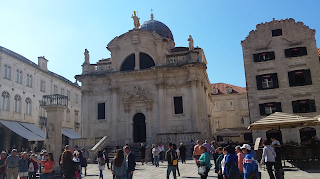Our guide spoke English extremely well. All of the group were Americans except for one couple from Eastern Europe. They spoke English as a second language. We were there in the off-season and there were quite a few people out and about. There were enough people to create a queue at the gelato shop. In July and August the crowds are quadrupled. Since the advent of the filming of The Game of Thrones in the area, the city has had to build five youth hostels for the crowds of young people visiting the city. Hotels in Dubrovnik are predominantly four or five star.
We entered the walled city of some one thousand years of age through Pile Gate. The walls and structures are of cut limestone blocks. The wall at some places is twenty feet thick. The city is encircled by the wall of some two and one half miles. We would have the opportunity to "walk the wall" once we reached the top, but first we would discover what ground level had to offer. One thing that was
immediately apparent to me was the Italian architecture. Dubrovnik was once ruled by the Venice. As soon as we walked through the gate we were on a small plaza, with a unique fountain in the corner. The domed structure was about twenty feet tall with a waist high trough around it. Water gushed into the trough from the mouths of sixteen ugly ornamental faces. It was designed by Onofrio della Cava, the architect and engineer who also designed the aqueduct which brings water to the city. He designed two fountains appropriately named Big Onofrio's Fountain and Little Onofrio's Fountain. Opposite the fountain is the Church of St. Savior, a church built in the late Renaissance style.
We continued walking leisurely down Placa, the main street, toward the clock tower visible at the end. I turned down the volume on my earpiece, through which the tourguide speaks, in order to hear Claudette's comments.
"We'll have to get a gelato at that shop befor we catch the bus back to the hotel," she said.
"I remember that gelato shop right outside our hotel in Florence. I think we tried every flavor," I said.
"But you wouldn't try licorice," my wife responded.
"There is something about black ice cream I don't like," I retorted.
" The building on the left is Sponza Palace. It now houses our national archives. You will notice both the Gothic and Renaissance styles of architecture. It was built between 1516 and 1522," said the tourguide.
Like all buildings it was built of limestone. I've never understood why limestone is so durable. On occasion I have been able to scratch a groove in the stone with my fingernail. It seems that a stone that soft would not be durable, but history proves me wrong. At the end of the street is one of the city's two belltowers. This one was built in 1444 and is one hundred and two feet tall. It was rebuilt in 1929 when the foundation had been damaged by an earthquake. Also on this plaza is the church of St. Blaise, the patron saint of the city. It was built by a Venetian architect in 1715 on the foundation of a Romanesque church.
We then began climbing up and up toward the top of the walls. The walls are thirteen to twenty feet thick and eighty feet high. For
The guide led us to the fast route back to the main street. Soon we were in the gelato shop. I had a cookie dough flavor and Claudette had adifferent flavor; I don't recall what i was. I don't know why I chose the cookie dough. I don't even like American cookie dough ice cream! We watched a television commercial being filmed while were there.
"Maybe we can check the out the souvenir shops before we get some lunch?" Claudette asked.
"Why not?' I responded.
There were souvenir shops close by which we stepped in to buy a few items. (Gotta have the T-shirt!)
 Close by was a lady with a number of beautiful tropical birds. There were parrots and macaws. She would allow tourists to have the birds sit on their shoulders, arms and/or heads. Usually a dutiful traveling companion would snap a photo and drop some money in the tip box. Naturally, an old man who always featured himself as a pirate of sorts had to have his picture taken with a parrot on his shoulder. Claudette, being the good wife that she is, complied with my wishes.
Close by was a lady with a number of beautiful tropical birds. There were parrots and macaws. She would allow tourists to have the birds sit on their shoulders, arms and/or heads. Usually a dutiful traveling companion would snap a photo and drop some money in the tip box. Naturally, an old man who always featured himself as a pirate of sorts had to have his picture taken with a parrot on his shoulder. Claudette, being the good wife that she is, complied with my wishes. I got my shirt and she got some jewelry. We left the walled city through Pile Gate and found a restaurant close by. We ate outside almost in the shadow of the walls. The vegetarian pizza was awesome. It was perfectly complimented by the local brew.
We throughly enjoyed our our day in Dubrovnik's Old Town. BTW Old Town is featured on the Croatian 50 kuno note.













